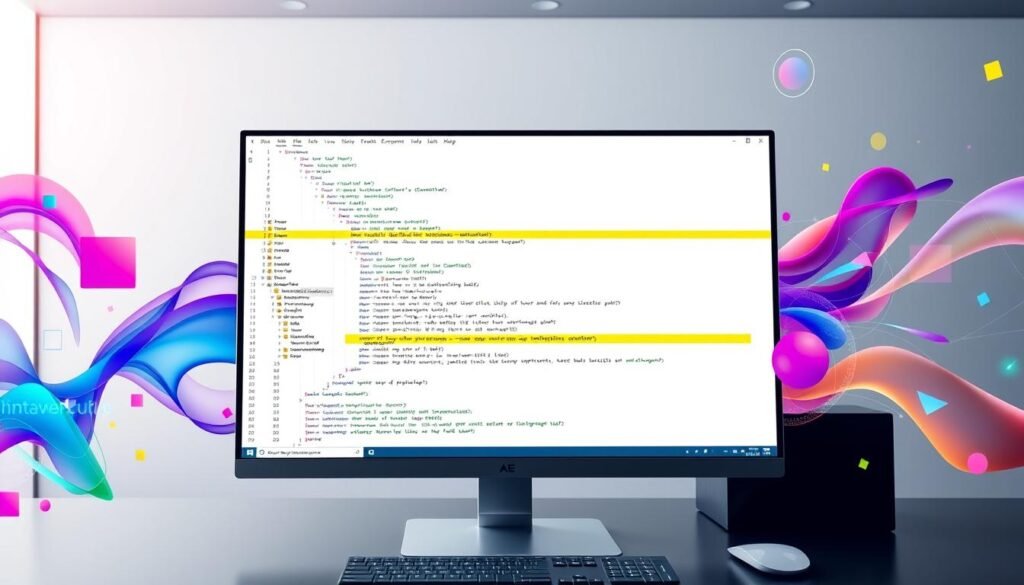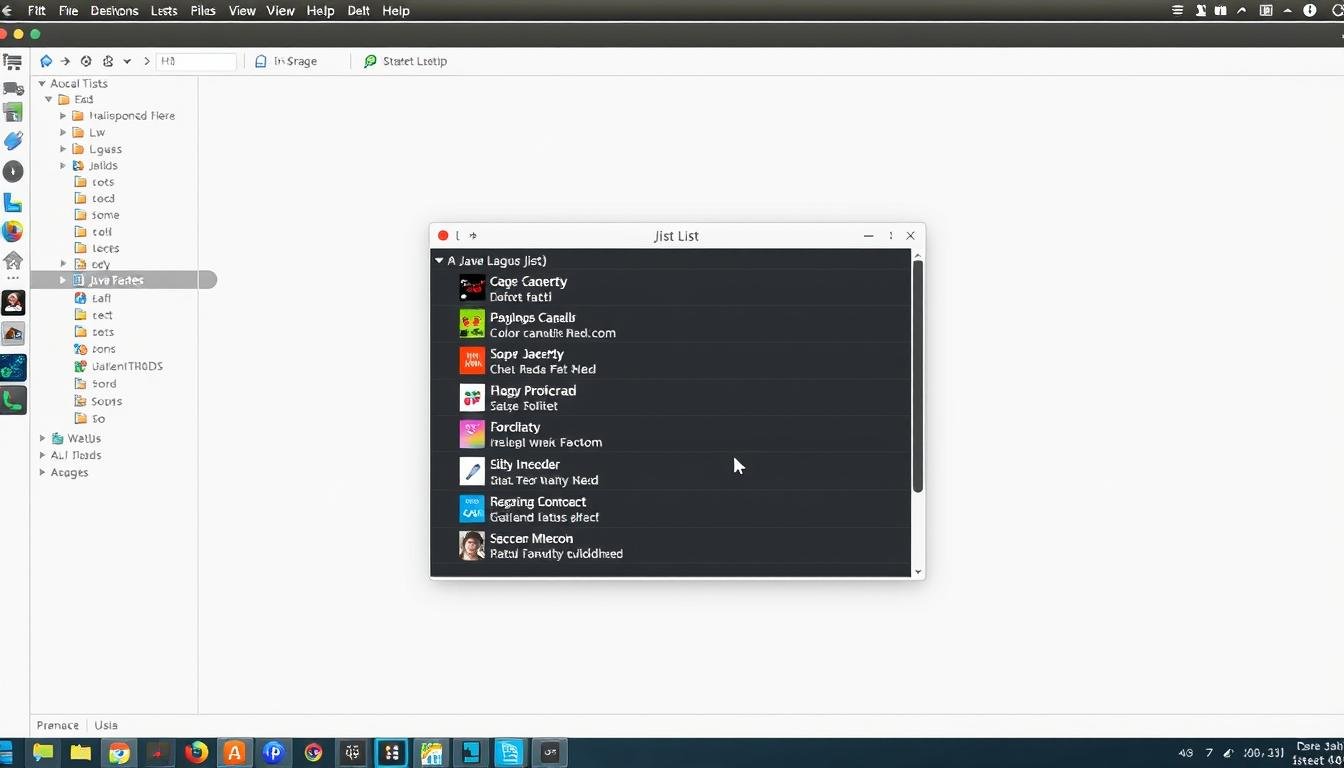JList is a powerful Swing component for creating dynamic visual interfaces. This guide will help developers master JList implementation in Java applications.
JList is versatile for displaying collections of data with interactive capabilities. It’s crucial for building desktop applications and complex software interfaces.
JList is essential for presenting scrollable lists of items. It helps create responsive and user-friendly graphical interfaces.
This guide breaks down JList implementation into easy-to-follow sections. We’ll cover basic configuration and advanced customization techniques.
You’ll learn practical ways to construct, style, and manage list components. Our instructions will help turn knowledge into real programming skills.
Introduction to JList in Java
JList is a powerful tool in the Swing GUI elements toolkit. It displays data collections in a scrollable list format for Java developers.
This component is great for desktop apps and complex software interfaces. JList offers a robust solution for showing information efficiently.
JList shows collections of items graphically. It allows for complex interactions and customizations beyond simple text displays.
Developers can fill lists with various data types. These include strings, numbers, and custom objects.
JList is simple yet adaptable. It supports multiple selection modes and custom rendering.
It integrates smoothly with other Swing components. Programmers can create scrollable lists and dropdown menus easily.
Understanding JList helps developers make better user interfaces. Its features allow for more engaging and user-friendly applications.
Mastering JList opens up many possibilities for Java developers. It’s a top choice for showing and managing data lists.
Setting Up Your Development Environment
Starting Java development needs a strong base. The first step is installing the Java Development Kit (JDK).
Oracle’s website has recent JDK versions for different platforms. Choose the right IDE to make coding easier.
IntelliJ IDEA, Eclipse, and NetBeans are popular IDEs. They offer tools that help with JList coding.
Set the JAVA_HOME path during JDK installation. This helps your system recognize Java commands.
Many IDEs have wizards to help set up JDK. Download a JDK version that works with your system.
Experts suggest using the Long-Term Support (LTS) version. After installing, test your setup with a simple Java command.
Pick tools that fit your coding style. Explore IDE options to find what suits your projects best.
Creating Your First JList
JList is a great tool for Java developers. It displays items in a graphical format for user interfaces.
To start, pick a data source for your JList. You can use an array or DefaultListModel.
Here’s a simple example of JList creation:
java
String[] cities = {“New York”, “Los Angeles”, “Chicago”};
JList cityList = new JList(cities);
This code makes a JList with three city names.
For complex data, try using DefaultListModel. It lets you add and remove list items easily.
JList is part of the Swing package. Import javax.swing.JList to use this component in your Java apps.
Customizing Your JList’s Appearance
JList customization enhances Swing applications visually. It goes beyond basic functions to create engaging user interfaces.
Swing styling offers ways to improve your JList’s look. Developers can change cell renderers for custom fonts, colors, and icons.
Custom ListCellRenderer gives full control over element appearance. Color and typography are key in JList customization.
You can set backgrounds, change text styles, and highlight items. Methods like setBackground() and setForeground() quickly transform the list’s look.
Advanced styling includes icon-based representations and gradient backgrounds. These make JLists more interesting and improve user understanding.
Good GUI design balances looks with usability. Keep readability and function in mind when styling.
Handling User Interaction

User interaction is vital for dynamic Java apps with JList. Selection listeners capture user actions and respond to list selections.
JList event handling lets developers track when users click or select items. The ListSelectionListener interface detects and responds to list selection events.
To add interactivity, create a ListSelectionListener and attach it to your JList. This lets you write code that runs when a user selects an item.
You can display details about a selected item or trigger specific actions. JList event handling offers many key techniques for developers.
These include checking for selections and getting the selected item’s index. You can also create custom response methods and handle events precisely.
Skilled developers can mix selection listeners with other event-driven programming methods. This creates complex user interactions in Java applications.
JList event handling allows for responsive interfaces that adapt to user input. These techniques help create intuitive and user-friendly Java programs.
Integrating JList with Other Components
JList integration enhances Java GUI layouts. It allows developers to create sophisticated user interfaces.
JList works well with JScrollPane for smooth scrolling. This combo manages large data sets without cluttering the interface.
Wrapping JList in JScrollPane creates adaptable scrollable lists. These lists adjust to various screen sizes effortlessly.
JList and JButton pairing boosts interactive features. Users can select items and trigger actions with buttons.
This approach simplifies user interactions. It also provides easy navigation in graphical interfaces.
DefaultListModel helps manage dynamic lists in JList integration. It allows real-time updates to list contents.
Developers can add or remove items programmatically. This flexibility is key for responsive GUI applications.
Smart component placement makes JList a powerful GUI element. Mastering these techniques leads to engaging software solutions.
Advanced JList Features
JList advanced techniques can transform standard list interfaces into dynamic, interactive components. Custom renderers create visually appealing and informative list displays.
Data filtering is crucial for large datasets. It allows dynamic control of visible list items based on user input.
Custom cell renderers let you personalize how list items appear. You can add icons, change colors, and embed interactive elements in cells.
JList techniques go beyond visual changes. Developers can create complex selection models and dynamic list behaviors.
Key strategies include understanding ListCellRenderer interfaces and implementing custom models. These methods turn simple lists into robust, interactive components.
Advanced features enhance user experience and boost application functionality. They allow for more responsive and user-friendly list interactions.
Best Practices for Using JList
JList optimization boosts performance and user experience. Efficient data management is key when using Java GUI components.
Picking the right model for your JList can make apps more responsive. Custom cell renderers can improve how lists look.
Special rendering can turn a basic list into an engaging interface. This lets you show complex data in better ways.
Lazy loading helps with large datasets. Try using pagination or virtual list models instead.
These methods cut down on memory use. They also make apps run faster overall.
Good memory management is vital for JList optimization. Remove unused list models and clear old references.
Proper garbage collection stops memory leaks. It keeps apps running smoothly.
Focus on user interaction when designing lists. Add keyboard controls and multiple selection options.
Give clear visual feedback to users. These steps make Java GUI apps easier to use.
Troubleshooting Common Issues
Java Swing developers face challenges with JList components. JList debugging can be tricky for beginners using complex GUIs.
Scroll bars not displaying correctly is a common issue. This can greatly affect user experience.
Understanding scroll functionality is key when fixing Java Swing issues. Solving JScrollPane problems needs specific coding.
Wrap JList inside a JScrollPane for smooth scrolling. This ensures proper list management.
JList errors often come from wrong component setup. Remove setBounds or setPreferredSize calls.
Let the Swing layout manager handle sizing and positioning. This avoids interfering with automatic layout management.
Data model setup is crucial for JList troubleshooting. Make sure your DefaultListModel is correctly filled.
Sync the model with your data source. This prevents null pointer exceptions and rendering issues.
Use lightweight rendering methods to boost performance. Create custom cell renderers for better results.
Avoid unnecessary model updates. This helps maintain smooth GUI interactions.
Resources for Further Learning
Quality Java learning resources help expand your knowledge of Java Swing and JList. Several excellent platforms offer comprehensive guidance for mastering Swing development.
Udemy and Coursera provide in-depth Swing development tutorials for various skill levels. The GeeksforGeeks Java Swing tutorial offers detailed documentation and practical examples.
Oracle’s official Java documentation is the go-to for technical details. GitHub and Stack Overflow provide practical insights for real-world Swing component challenges.
Books like “Java Swing” by James Weaver cover Swing components thoroughly. These help programmers develop advanced graphical user interfaces with JList techniques.
Open-source communities offer support for Java Swing technologies. Reddit’s Java programming subreddit creates a collaborative environment for learning.
Using diverse Java learning resources keeps developers updated with the latest techniques. This ensures they stay current with best practices in Swing development.
Conclusion
You’ve gained powerful Java GUI skills for Swing applications. These techniques provide a foundation for building sophisticated list-based interfaces.
Swing application building needs practice and testing. Understanding JList components helps design flexible interfaces.
JList is one tool in the Java Swing toolkit. Try different options and explore event handling methods.
Practice makes these techniques more intuitive. Keep challenging yourself with complex list-based interfaces.
Your new skills open doors to professional Java apps. Keep learning and stay curious about JList and Swing.
